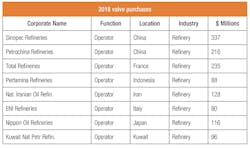Creating a sales program based on valve forecasts
Bob Mcilvaine is the president of the Mcilvaine Company in Northfield, Illinois. Mcilvaine provides market research and technical analyses on industrial valve purchases. He may be reached at [email protected] or847-784-0012, ext. 112.
Fifty thousand companies purchase 97 percent of industrial valves.¹ Large corporations such as BASF and ArcelorMittal are centralizing purchasing, remotely monitoring combust, flow and treat (CFT) components and using data analytics to determine lowest total cost of ownership. One company recently announced an Industrial Internet of Things (IIoT) program for 450 plants around the world.
Ninety-nine percent of all industrial valves are sold to companies that have purchased these components previously. Most purchases are replacements, repairs or part of previously announced expansion plans. The successful sale of high-performance valves starts long before a request for quotation. Therefore, a sales program focused on the specific prospects — valve forecasts for each major purchaser — rather than current intelligence is the successful route.
The first challenge is to accurately identify each of the thousands of prospects. A numerical identifier is necessary because of the many variations in spelling with language conversions. Also Chinese companies have requirements to list the city before the name. This adds additional confusion. See Table 1 for an example of the numerical identification system.
Table 1. Chinese numerical identification system
Forecasts for each important purchaser should be the foundation of a sales program.² Large purchasers such as the refineries listed in Table 2 should receive special attention.
Table 2. 2018 valve purchases by large refineries
The valve purchasers are now utilizing data analytics to gain insights relative to the cost of ownership of various valves with various materials of construction. They are seeking discussions with valve supplier personnel who are well versed on the processes and problems they encounter. Whereas the IIoT can create smart valves, it cannot create smart people. This is where the Industrial Internet of Wisdom (IIoW) is needed to empower IIoT. IIoW links knowledge and people.
The valve vendor can create a powerful IIoW intelligence system simply by linking to articles and presentations that are archived in magazines and other resources. For example, the article "Valve selection for ethylene production" by Crane ChemPharma & Energy published in a 2015 issue of Processing provides valuable insights on valve types and issues in ethylene manufacture. It contributes to understanding of the best valve types to use in refinery and petrochemical processes. Cracker-unit valve selection plays a critical role in maximizing quality ethylene output. Several valves are involved in obtaining the appropriate input ratio of inputs. Check valves ensure backflow protection. The point is to restrict coke buildup and inline leakage. Wedge-plug valves play a valued role along the cracker lines in the furnace unit, as they have been developed to accommodate challenging media like naphtha feedstock. They can eliminate operational issues caused by coke contamination and buildup within the valve.
Factors, like materials composition and coatings, are also considerations when selecting valves for the cracking stage of ethylene production. In such high-temperature settings, for example, valves with graphite packing are an ideal solution compared to PTFE-packed alternatives. The article also addresses maintenance challenges at various points in the processes.
For easy retrieval and maximum value, vendors should tag data like this example article with decisively classified terms covering industries, processes and products. The system can be continuously updated to reflect technical, project and other information relative to each individual prospect. In this case, for example, data would include:
- The article URL: https://www.processingmagazine.com/valve-development-meets-needs-of-harsh-ethylene-production/
- Tags: 325110 – Petrochemical Manufacturing 石化产品生产, ethylene , valve, Crane CP&E, Processing
The cost to create a comprehensive IIoW system will be substantial. However, valve suppliers can work with OEMs and end users to share and properly classify data. Publishers and conference organizers will have an incentive to use a common system for easy retrieval. The commercial incentive is the ability to display advertisements along with retrieved information. Many publishers are using this format.
The accurate and comprehensive forecasting of the valve opportunities at each relevant prospect is both the catalyst to invest in the balance of the program and the crucial aspect for the sales team.
References
1. Valves: World Market, by the Mcilvaine Company
2. IIoW Based Business Program, by the Mcilvaine Company



